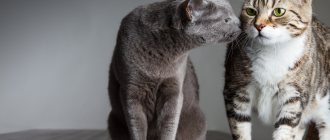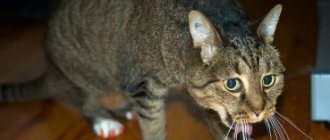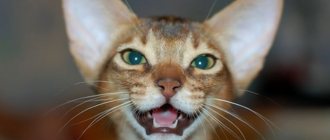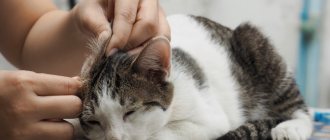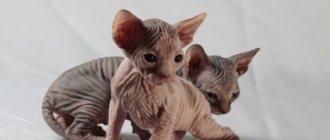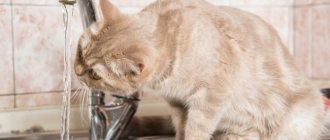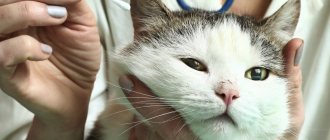Structure and functions of language
The cat's tongue consists of transverse and longitudinal muscles that provide its flexibility and mobility. Cats can pull it strongly, move it in different directions, and roll it into a ladle shape (for example, while drinking). Primarily, this organ is used for eating. However, it also provides thermoregulation. With its help, the cat cools its skin by licking itself intensively in hot weather. A tongue sticking out can be an indicator of overheating of the animal's body.
The upper layer of the tongue is covered with special hard papillae that resemble thorns. The animal needs them not only to hold food or drink in its mouth, but also to thoroughly clean the fur, remove accumulated dirt and large insects. Thanks to this property, cats practically do not need to be washed, unlike dogs. However, cats cannot remove all the cleaned debris (including hairs) from the tongue and swallow it. Therefore, the owner should help his pet in caring for the fur to prevent its accumulation in the animal’s intestines.
The most common causes leading to cyanosis in cats
pneumothorax and hydrothorax
Most often it occurs as a result of injuries in the chest area, falls from a height, car injuries, and bites. Pneumothorax
- accumulation of air in the chest cavity,
hydrothorax
- accumulation of fluid. In these conditions, the lungs are unable to fill with air normally, and in some cases, part or one entire lung collapses (does not function). If the process of fluid or air entering the chest cavity does not stop, the animal dies from suffocation.
If you notice that for some time your animal begins to breathe worse, develops shortness of breath (breathing frequently and with an open mouth) and cyanosis (from several minutes to several days after injury), you need to contact the clinic to exclude these life-threatening conditions. states! To confirm this diagnosis, the doctor will need to take x-rays. And then the fluid or air is removed from the chest cavity. This procedure is usually performed under sedation (a small dose of a sedative); in some cases, general anesthesia is required.
It is also necessary to identify the cause of this condition. This may require testing of fluid removed from the chest cavity. Further treatment will be aimed at preventing the onset of symptoms and treating the disease that caused them.
, diaphragmatic hernia often occurs when falling from a height.
(rupture of the diaphragm and prolapse of abdominal organs into the chest). In this condition, the lungs are also inadequately filled with air due to their displacement. Lack of oxygen and cyanosis develop.
This problem is solved surgically - all organs are returned to their places, and the rupture in the diaphragm (the tissue separating the chest from the abdominal cavity) is sutured. However, such an operation is appropriate only if the diaphragm rupture has occurred recently; with old injuries and a normal quality of life of the animal, surgery is not always indicated.
Causes that also cause chest effusion in cats are FIP
, or
feline infectious peritonitis
, and
lymphosarcoma
(feline viral leukemia). With these diseases, fluid accumulates in the chest and abdominal cavity (not always), the general condition of the animal worsens, the cat refuses to eat, and cyanosis appears. To make such diagnoses, examination of the detected fluid will be required. Blood tests and ultrasound of the chest and abdominal cavity.
Pulmonary edema
A very life-threatening condition - requires urgent assistance and immediate treatment to the clinic! In addition to cyanosis, pulmonary edema is also accompanied by other symptoms: incessant shortness of breath (the cat breathes with its tongue hanging out), anxiety. When an animal with such symptoms arrives for an appointment, the doctor will urgently assess the animal’s condition and decide on the need to place the animal for inpatient treatment (which is indicated for animals with severe symptoms of respiratory failure). Also, at the very initial stages of diagnosis, it is necessary to determine the nature of the edema - its cause (since this is not an independent disease, but only a clinical manifestation of some hidden problem in the body).
An X-ray of the lungs is required to confirm the diagnosis, determine the severity of the condition and detect a possible cause. To relieve the symptoms of edema and improve the animal’s condition, it will be given active diuretic (diuretic) therapy.
After the animal’s condition has normalized and the cause of pulmonary edema has been identified, the cat should receive treatment for its underlying disease in order to avoid recurrence of this symptom.
Cat asthma
Feline asthma is a disease of cats of all ages, accompanied by coughing and deterioration of breathing; in severe cases, respiratory failure and cyanosis develop. This disease can be suspected by detecting characteristic changes in the lungs (on a lateral X-ray) and confirmed by detecting an increased number of eosinophils (blood cells responsible for the body’s immune response) in the blood.
This disease in cats is of an immune nature - therefore, to treat it, the cat is prescribed and selected a minimum dose of glucocorticoid hormones for lifelong use.
Congenital heart defects
Congenital heart defects may also be the cause of these disorders.
A cat's strong, long, spine-covered tongue performs many functions. Based on the condition of this organ, an attentive owner may notice that the cat is sick. For example, if an ulcer appears on a cat’s tongue, calcivirosis is suspected. Knowing what a healthy cat’s tongue should look like, how cats use their tongue in a given situation, why a cat sticks out the tip of its tongue and other useful “little things”, the owner better understands his pet.
The cat's tongue, like the human tongue, consists of many transverse and longitudinal muscles, with the help of which our pets can not only extend and hide their tongue in the mouth, but also move it in different directions and fold the tongue into a ladle. The latter is especially convenient when drinking - water is retained in the recess without splashing out of the mouth.
One of the reasons why a cat sticks out the tip of its tongue is a function of thermoregulation. The wet tongue quickly releases some of the heat accumulated by the cat's body, somewhat easing the pet's condition in extreme heat. If the pet is very hot, the cat breathes heavily with its tongue hanging out. For dogs, this behavior is the norm, but for cats it is a signal that the ambient temperature has reached a critical norm. If you don’t help your pet, it’s possible.
Although the reason why a cat sticks out the tip of its tongue may be much more banal - the pet recently ate or washed itself, and simply “forgot” to put its tongue in its mouth. Owners of Persians and exotic cats notice this especially often - the cat sticks out its tongue, as if teasing others. It's all about the shortened bones of the skull: the shape of the muzzle has been changed by selection, as well as the structure of the jaws - the tongue either does not fit in the mouth, or the tip sticks out between the teeth (malocclusion, in which the cat shows the tongue, which normally rests from the inside against the teeth tightly interlocked when the mouth is closed ).
An inexperienced owner, especially if he has previously had close contact with dogs, is always surprised why a cat has a rough tongue. The touch of a cat's tongue can even be unpleasant - the surface of this organ is so hard and prickly. Residents of Ancient Rus' did not have the opportunity to examine a cat’s tongue in close-up, but the tactile sensations were enough for them to give the cat’s tongue the apt nickname “grater.” It's all about the many papillae, like spikes, growing inward towards the pharynx. Long “scales” help the cat retain food and water on the surface of the tongue, thoroughly clean the coat and remove small debris from the surface of the fur - the dog will never be able to wash itself so cleanly.
Knowing why a cat has a rough tongue, it is not difficult to imagine what happens to tinsel or thread that gets into the cat’s mouth: the pet cannot spit out the thread (the “spikes” on the tongue that hold a thin foreign object interfere). The cat swallows thread or tinsel - there is simply nothing left for it. Having noticed this, you should not pull the end of the thread: carefully cut off the visible part and give your pet a couple of tablespoons of Vaseline oil.
If you look at a cat’s tongue close up, you will notice that in addition to “spikes”, it is covered with short “sticks”, flat dots and other “growths” - these are also papillae, and they all perform certain functions. In particular, many of them are equipped with taste chemoreceptors, which allow the cat to sense salty, sour and bitter tastes. Examining a cat's tongue under a microscope, scientists were unable to detect receptors sensitive to sweet taste, so it is believed that cats do not feel this taste at all. Or they can taste it, but only in high concentrations, which is harmful to their health.
Dark spots and dots on the tongue and lips of cats are a consequence of hyperactivity of the cells that secrete the pigment responsible for skin tone. Fluffy pets are prone to pigmentation. Black spots on a cat's tongue can appear from birth. In this case, the tongue can be either highly pigmented or weakly, with barely noticeable spots. Pigmentation can spread to the nose, oral mucosa and lips. This phenomenon is absolutely harmless and does not require treatment.
Black dots that suddenly appear on a cat’s tongue are a consequence of the activity of the cells responsible for skin color. Due to increased pigment production, some areas of the mucous membrane become darker in color. This phenomenon is not dangerous, regardless of whether it is acquired pigmentation or the cat has had spots since birth.
Age spots can form as you age. If a cat is prone to such formations, dark spots appear before the age of three. If the animal does not have a tendency to pigmentation, the tongue and nose can remain clean throughout its life.
Many owners mistake black spots on the tongue for symptoms of a fungal infection. Candidiasis and other dermatological diseases of the mucous membranes and skin in cats are manifested by the formation of light spots and dots, but not dark ones. Pigmentation does not cause discomfort. When dark spots appear, the pet’s behavior does not change, appetite does not suffer, and in general there is no cause for concern.
Interestingly, pigmentation in cats is often hereditary and appears in animals with dark fur and dark paw pads. In light cats, white or red with pink paws, pigmentation is very rare.
Pellagra
A disease caused by a lack of vitamin PP and B6 is called pellagra. In cats, this pathology is quite rare and is associated with a monotonous diet. In most cases, hypovitaminosis occurs in animals that eat low-quality dry food in a low price segment. The composition of such feeds is not balanced and does not always meet the needs of the animal’s body for certain vitamins. Pellagra can also be encountered by street animals that do not have a regular diet and eat whatever they can find. Often cats taken from the street suffer from hypovitaminosis, and the owners cannot immediately understand the reason for the lethargy and drowsiness of their furry pet, as well as dark spots on the tongue.
Pigmentation in cats
Black dots that suddenly appear on a cat’s tongue are a consequence of the activity of the cells responsible for skin color. Due to increased pigment production, some areas of the mucous membrane become darker in color. This phenomenon is not dangerous, regardless of whether it is acquired pigmentation or the cat has had spots since birth.
Age spots can form as you age. If a cat is prone to such formations, dark spots appear before the age of three. If the animal does not have a tendency to pigmentation, the tongue and nose can remain clean throughout its life.
Many owners mistake black spots on the tongue for symptoms of a fungal infection. Candidiasis and other dermatological diseases of the mucous membranes and skin in cats are manifested by the formation of light spots and dots, but not dark ones. Pigmentation does not cause discomfort. When dark spots appear, the pet’s behavior does not change, appetite does not suffer, and in general there is no cause for concern.
Interestingly, pigmentation in cats is often hereditary and appears in animals with dark fur and dark paw pads. In light cats, white or red with pink paws, pigmentation is very rare.
Household application of research results
Researchers at the Georgia Institute of Technology intend to patent the results of their work for further use in everyday life. This knowledge can be useful for developing new brushes and other equipment for cleaning wool surfaces (carpets, clothes, etc.), as well as for caring for human hair and animal hair.
According to scientists, recently the global industry that creates cleaning products has been devoting more time to developing new washing liquids than upgrading brushes. Cleaning products most often contain toxic substances, which, directly or indirectly, can harm health and the environment by settling in water and soil. At the same time, brushes, even those made of plastic, have a long service life and are less toxic compared to household chemicals. Copying the unique structure of a cat's tongue can be used to create new devices for cleaning difficult wool or fabric surfaces.
In addition, the principle of penetration of papillae into the deep layers of the coat can be used to develop objects that allow the delivery of drugs to the skin through thick fur or hair (without shaving this area). It can be used medically in the treatment of dermatological diseases in both humans and animals.
Alexis Noel and her colleagues have already demonstrated a new product - TIGR (tongue-inspired grooming). It is a brush with two rows of teeth imitating the papillae of a cat's tongue. The brush was created using a 3D printer. Soft teeth allow you to comb human hair gently and effortlessly, even with tangled strands. Also, the brush successfully untangles knots made from artificial and natural threads. Thus, such a product can be used, among other things, in the textile industry.
Treatment
The treatment your veterinarian prescribes depends on the cause of the dark spots and spots. For example, acne is a consequence of liver dysfunction, especially in old animals. Treatment in this case includes changing the diet in such a way as to minimize the load on this organ.
It is important to prevent stress; cats should be comfortable in the house. Bowls and tray must be clean. It is better to replace plastic bowls for food and water with glass or stainless steel bowls to avoid allergic reactions.
It is best to use glass dishes and stainless steel bowls when feeding cats.
It is necessary to use vitamin supplements for cats aimed at normalizing the functioning of the immune system. To rule out food allergies, you can switch your cat to diet food and medicated food.
Infectious diseases in cats are quite easy to identify, since this will affect the behavior of the pet. Infections weaken the body, the animal becomes apathetic, lethargic, refuses to eat and sleeps a lot. But the occurrence of infections can also be determined by black spots on the tongue, lips, and around the mouth.
For predators, the condition of teeth and gums is of particular importance. The easiest way to prevent serious oral diseases is to have your teeth cleaned regularly by a veterinarian. The doctor will help not only remove plaque from the cat’s teeth, but also get rid of tartar. It will also apply a special solution to strengthen and prevent re-formation of the stone.
Only a veterinarian can make a correct diagnosis after examination.
Coated tongue
Quite often, black spots on a cat’s tongue go away after eating or drinking water. In this case, we are talking about the usual plaque that appears when eating dark-colored food. Often, a coating on the tongue is discovered after the cat plays with some objects painted in a dark color.
It is very easy to distinguish plaque from pigmentation or vitamin deficiency; just rub your pet’s tongue with a toothbrush. If the dark spots disappear easily and do not appear again, we are talking about plaque. With pellagra, dark areas may clear up, but re-form after some time. Pigmentation on the tongue cannot be removed with any available means.
Owners should be concerned if a dark coating forms on the pet’s lips and nose, and there is also a pronounced putrid odor from the cat’s mouth. In this case, it is recommended to show the animal to a veterinarian and examine the oral cavity. Possible causes include dental disease, gum inflammation and bacterial stomatitis.
We invite you to read: How cats see our world, in what colors, why cats see in the dark
According to many people, cats are one of the most tenacious creatures. Is this really how it is?
Indeed, it is difficult to classify cats as sick creatures. They are less susceptible to various diseases than other animals. But like any animal, cats can get sick with specific feline diseases or catch a cold, and they can become obese.
It is worth mentioning that domestic (pedigreed) cats are more susceptible to diseases than barn cats. Long-haired cats get sick more often than short-haired cats.
Determining the symptoms of the disease in cats is quite problematic.
Language and symptoms
- A red or bluish tint to the tongue, gums, lips and skin may indicate blood disorders.
- Worsening or difficulty breathing
- Coloration of paw pads bluish or reddish.
When your cat develops cyanosis and you, not knowing what to do, are looking for advice on this topic on the Internet on forums, we recommend not to self-medicate or experiment on your beloved cat. The fact is that there are many reasons for cyanosis in an animal, and the consequences of your experiment may disappoint you and your family.
Although cats are speechless, a pet's language can tell a lot about her health. For example, a cat’s white tongue, covered with plaque, indicates problems with the gastrointestinal tract, intoxication, fever, and constipation. If the tongue itself turns pale, shock, anemia, vascular disorders, heart disease, and hypothermia are suspected. Yellow plaque - check the kidneys and liver. Grayish, brownish - lungs, intestines, stomach.
We suggest you read: Tsiprovet for cats: instructions for use in veterinary medicine, price
An ulcer on a cat's tongue can form as a result of trauma - biting, stabbing with a twig, or scratching with a claw. Usually, when you can look into the mouth, the damage is easy to notice. In this case, it is enough to treat the wound with an antiseptic and ensure that the sore heals quickly. No improvement within two to three days - see a doctor. If there are several ulcers, stomatitis, a bacterial or viral infection is suspected - a reason for an immediate visit to the clinic.
Viruses, severe pain or fever are suspected if the cat is breathing heavily with its tongue hanging out. In this situation, it is important to carefully examine and feel your pet, measure its body temperature and, of course, consult a doctor immediately.
If your cat has spots, strange grooves, or pimples on his tongue, be sure to show your pet to the veterinarian. There are many reasons for changes in the color and structure of the surface of the tongue, from fungi and bacteria to all kinds of viruses and chronic diseases of internal organs. Without treatment, necrosis of a cat's tongue may begin - tissue necrosis at the cellular level, an irreversible process. In this case, part, or even all, of the language will be removed. And you will be very lucky if the tissue of the oral cavity is not involved in the process.
A black tongue in a cat may be a symptom of an acute deficiency of vitamin PP. Although more often the pet simply licked something colorful - a fur collar of a jacket, a belt, etc. Sometimes a cat gets dirty with something, and then, while licking itself, scares the owners with a tongue of an unnatural color: particles of the substance, licked from the fur coat, get stuck between the papillae, turning the pinkish tongue into black, blue, green or bright red. The latter, that is, a red tongue, may be the beginning of an inflammatory process or a sign of high blood pressure.
If the owner notices that a cat has been bitten on the tongue by a wasp - this usually happens when the pet gnaws out a caught wasp stuck between its fingers - action must be taken immediately. The tongue has many nerves and blood vessels. Poison that gets into tissue spreads quickly. If an allergic reaction (swelling) begins, the pet may die.
We suggest you read: What to feed a cat after giving birth Rules for a healthy diet
To be on the safe side, you should give an intramuscular injection of diphenhydramine (or suprastin, but diphenhydramine is preferable). Dosage – 0.5 for a medium cat, 1 ml for a large pet weighing more than eight kilograms. Now all that remains is to observe your pet: if swelling still becomes noticeable, consult a doctor immediately.
Communicating with facial expressions
This type of communication can include, for example, the fact that a pet greets its owner, begs for food, or expresses protest. The language of cats is an amazing lexicon. In each individual case, the purr produces corresponding sounds that differ in tone, strength or timbre. Note that the state of pain, aggression and fear is accompanied by lower sounds, and complacency and satisfaction are accompanied by high ones.
If you know a little about the language of cats, you can understand their psychology. For example, purring means that the pet is not aggressive. With this trill, mother cats call their kittens. These animals also purr when the owner returns home.
Rumbling is a warning sound to others. Low is a sign that the cat is ready to defend itself. Snorting and hitting the ground with a paw is a signal for a fight with a more serious enemy.
Another interesting sign that a cat gives is the chattering of its teeth. This signal can be seen when it sees prey.
Meowing is conversation. however, the cat uses it very rarely when it wants to go out or eat.
How to understand the language of cats? Simple, if you know her facial expressions. The entire arsenal of cat gestures is innate. The half-closed eyes of a cat signify relaxation and tranquility. Wide eyes indicate concern.
If the environment frightens the cat. Looking point blank is a challenge, and the same thing is meant. If she looks to the side, then this is how she shows submission.
Now let's look at their meaning. The tail is particularly expressive. If it is raised up, then the animal is friendly. Remember how kittens' tails stand. Of course, upward, because they are just learning about the world, they are interested in everything new. If a cat is scared, its tail is between its paws. Fluffy is a symbol of an aggressive attitude.
Dominant cats have their tails held high, while subordinate cats have their tails lowered. If a pet knocks on the floor with it, then it becomes angry. When the tail moves quickly from side to side, this is a sign of severe aggression. Lightly waving the tip of the tail means the cat is relaxed.
Cat tongue disease
Diseases of the oral cavity and pharynx in cats are not uncommon and are interpreted as oropharyngeal. Their range is wide, from mild, not requiring hospital treatment, to difficult to treat. A cat's oral cavity has a slightly alkaline environment; antibacterial enzymes contained in saliva provide protection against bacterial infections.
Causes of diseases
With a strong immune system, pathogens do not cause significant harm to the cat. The animal's saliva contains thiocyanate ions, which destroy bacteria, and lysozyme, an enzyme that lyses food particles and prevents microorganisms from feeding.
When the body’s defenses are weakened, the oral cavity and pharynx are at the forefront; the gums (gingivitis) and tonsils are especially affected.
The formation of tartar begins with plaque; when bacteria attach, the plaque thickens and gradually increases.
The very first symptom of oral diseases in cats is anorexia, food refusal. This is explained by pain when chewing and swallowing food. A typical symptom is a cat sitting near a bowl or water, trying to eat (drink), but cannot due to a strong inflammatory reaction and pain.
Inspecting the oral cavity at home on your own is problematic; even a calm animal does not allow the owner to forcibly open its mouth.
Heavy, bad breath indicates a problem with the teeth (tartar), infection, ulcers, or suppuration.
An unkempt appearance in a cat indicates that it has stopped licking itself, which is almost impossible with diseases of the oral cavity. Drooling, which causes the fur on the chin and front legs to become damp, is a symptom that indicates a problem.
Symptoms of oral diseases in cats:
- lack of appetite;
- dysphagia (difficulty swallowing);
- ptyalism (excessive drooling);
- halitosis (pungent odor);
- weight loss;
- trying to get something out of your mouth.
With stomatitis and gingivitis, a strong odor from the mouth is felt from a distance. You can suspect a foreign body in the pharynx based on symptoms of choking, nausea, drooling and difficulty swallowing.
Cats suffer most from gum disease that develops as a result of feeding poor quality food. Symptoms: hyperemia, swelling, ulcers, similar to signs of scurvy.
Upon examination, reddened, swollen gums are visible, painful with areas of bleeding. If left untreated, the gums gradually recede from the tooth, forming pockets in which food accumulates. Putrefactive inflammation, caries, and periodontitis develop. The cat refuses to eat, becomes weaker, has unkempt fur, and saliva may flow from its mouth.
Infectious pathology, glossitis, indicates immunodeficiency conditions, feline leukemia, acute respiratory disease, viral immunodeficiency syndrome. Sometimes the inflammatory process appears when exposed to external factors, licking highly irritating substances.
Symptoms: profuse salivation, sometimes foamy, anorexia, pain. Externally, the cat looks unkempt. After healing and disappearance of the inflammatory process, the surface of the tongue is smoothed, it becomes varnished, smooth without a hard brush.
Erosion and ulcers often form.
Oral disease is manifested by severe salivation and inflammation of the mucous membrane. The cat refuses to eat, inspection of its mouth is difficult, it rubs its face with its paws and shakes its head.
Redness and swelling are noticeable on the mucous membrane, gums bleed, and there is a strong odor from the mouth. The cat seems to be “ruffling up”, looking unkempt and disheveled.
In young cats, candidiasis (thrush) is diagnosed; the disease becomes more pronounced when treated with antibiotics, steroids, with low immunity, or after a serious illness.
This is a rare disease of the oral cavity, occurring as a secondary pathology against the background of a viral infection, diseases of the mouth and pharynx. With pharyngitis, the temperature rises, pain, cough, and nausea appear. No appetite.
Inflammation of the tonsils is rarely diagnosed in cats. Hyperthermia (above 39.4C), lethargy, and anorexia are observed. The underlying cause of the disease is a bacterial infection.
In case of recurrent tonsillitis, removal of the tonsils is indicated, since greatly enlarged tonsils interfere with the normal passage of air into the lungs, cause attacks of suffocation, and interfere with food intake.
- Neoplasms of the salivary glands.
Cysts and tumors form under the influence of external factors. As a rule, the salivary gland is damaged in cat fights, when a foreign object enters. The accumulating fluid ruptures the duct and a cyst is formed - a mucocele.
In older cats, tumors are (usually) malignant and appear as hard, slow-growing lumps on the side of the face or neck.
Needles, bones, fragments, chips, thorns, threads get into the oral cavity. The specific structure of the tongue with papillae curved inwards does not allow a foreign object to fall out. It is easy for a breeder to understand that something has got into the cat’s mouth; she shakes her head, meows, and tries to reach with her paws what is bothering her. Severe drooling, restlessness, refusal to eat.
Particularly dangerous are the bones from fish, which dig into the soft tissues of the mouth and pharynx and “sit” there without causing signs of concern. After a few days, the bone rots, a strong odor from the mouth appears, intoxication, weakness, and apathy develop. If the outcome is successful, the bone comes out with a ruptured abscess and pus.
We invite you to read why cats' eyes glow in the dark
It is found in the middle of the upper lip, sometimes on the lower or oral mucosa. It looks like a yellow or reddish shiny spot that turns into a weeping erosion without pain or itching.
Diffuse growth: the ulcerated surface increases, teeth and gums are exposed. Jacobs ulcer has a tendency to develop into cancer or fibrosarcoma.
The cause of the pathology is not clear; a connection is suggested with dental infections and the feline leukemia virus.
In fights, cats receive lacerations in the mouth area; less often, the animal injures itself by accidentally biting its lip. The tongue can be cut on sharp objects (tin cans), or peeled off by accidentally licking an iron object in the cold.
Squamous cell carcinoma, a malignant tumor, forms around the nose and on the lips, mucous membranes of the mouth and tongue. Neoplasia must be differentiated from eosinophilic ulcers by biopsy.
Cleft lip in cats, a congenital defect, is characterized by incomplete development of the upper lip. The pathology is visible at the birth of a kitten, sometimes the cleft lip is combined with a cleft palate.
Cleft palate, a disease most often of a genetic nature, is sometimes diagnosed along with cleft lip. The disease manifests itself in the first day of life, the kitten has difficulty sucking milk, and it leaks into the nose. The anomaly is accompanied by constant sneezing, noises are heard when breathing, and pneumonia develops when milk gets into the lungs.
Any disease requires the attention of a veterinarian and consultation within the walls of a veterinary clinic. The first symptoms of illness cannot be ignored. Diseases of the oral cavity and pharynx in cats are easier to treat at first. In advanced cases, excessive efforts will be required, and sometimes the disease ends in death.
Congenital pathologies of the tongue alone are uncommon, and even if puppies or kittens have significant malformations, such as cleft palate, the tongue is often normal. A condition known as bird tongue has been described in puppies. It is characterized by pathological narrowing of the organ with deformation and impaired swallowing. The defect is presumably caused by a simple recessive gene.
Most tongue diseases are acquired, often traumatic and inflammatory (glossitis), the latter usually part of the stomatitis syndrome.
Damage to the tongue occurs due to bite wounds or licking of sharp objects and rough surfaces. Other injuries include chemical or electrical burns and, less commonly, the tongue getting caught in a loop of nylon fishing line or thread.
Clinical symptoms: the animal scratches its mouth with its paw and secretes saliva and blood. Damage to the tongue is visible upon examination.
Treatment includes controlling bleeding, stitching up tears and, if necessary, possibly amputating part of the tongue (the dog does well without the front third of the tongue).
Loops and foreign bodies should be removed under general anesthesia followed by broad-spectrum antibiotics.
Glossitis is the most common tongue disease, especially for cats, where ulcerative glossitis associated with herpes virus (feline rhinotracheitis virus) and calicivirus (calcivirus infection) may be incurable.
The primary goal in treating these cats is to provide adequate nutrition and hydration for severe pain and resulting dysphagia. Pharyngostomy intubation may be required to overcome the acute phase of the disease.
Cats with eosinophilic lip granulomas may have lingual or sublingual lesions.
Squamous cell carcinomas in cats can affect the tongue at the root or when invading from a primary gingival site. When treating these tumors, radiation or thermal therapy can be used if the necessary devices are available. Tumors of the tongue are rare in dogs.
Some pet owners notice that their cat has a blue tongue. This is an alarming symptom. It does not refer to a separate disease, but is a sign of certain pathologies.
The color of the mucous membranes depends on the filling of the blood with carbon dioxide and oxygen. If there is a deficiency, the cat's tongue becomes bluish in color. This phenomenon is called cyanosis. If it is long-lasting and persistent, then the cat will feel worse and worse – to the point of death. The blue color can become dark, almost black, or purple-red.
Why doesn't a blue tongue always indicate illness? A cat can simply lick a blue item, and the stuck lint will visually change color. In another case, the animal may accidentally lick blueberry juice or dyes. They will temporarily turn the tongue an unnatural color.
- pneumothorax - filling of the sternum with air;
- hydrothorax is an accumulation of fluid in this area.
In both cases, the cat feels a lack of air.
The lungs may stop functioning on the right or left side - partially or completely.
If the processes of pneumo- and hydrothorax do not stop, the tongue takes on an increasingly blue tint, and the animal dies from an attack of suffocation.
Cyanosis (blue tongue in a cat) can develop in minutes or over several days. At the same time, the shade becomes more and more saturated. In this case, frequent breathing is observed (the animal’s mouth is open at this time) and shortness of breath. Cyanosis can also be caused by:
- Diaphragmatic hernia, when the membrane in the peritoneum ruptures and organs fall into the chest. Due to the displacement, the lungs do not receive enough oxygen. This can be determined by examining the cat's tongue; the surrounding mucous membranes also turn blue.
- Infectious peritonitis or FIP, viral leukemia (aka lymphosarcoma). In these conditions, fluid accumulates in the abdominal cavity, and the animal’s tongue turns blue.
- Pulmonary edema is one of the most dangerous diseases. In addition to cyanosis, there is constant severe shortness of breath and anxiety.
- Asthma is accompanied by worsening breathing and coughing. Blue tongue and respiratory failure appear in severe forms of the disease.
Cat shows tongue: normal or pathological
Cats are cocky creatures and can tease their relatives, but they do it differently than small children sticking out their tongues at each other. If the owner identifies rational reasons, you can calm down. You just need to find out from an experienced felinologist whether the protruding tongue is a defect that is inherited by the offspring and whether the animal can be used for breeding.
When the cause of the protruding tongue cannot be determined or pathological symptoms are detected, it is necessary to seek veterinary help.
Be sure to read: Why cats leave home: the main reasons, what to do, how many days they can walk
Why do mucous membranes turn blue?
The color of the mucous membranes depends on the saturation of the blood with oxygen and carbon dioxide. If for some reason a sufficient amount of oxygen does not enter the blood, the mucous membranes acquire a bluish tint. If cyanosis is persistent and the body does not receive the required amount of oxygen for a long time, a serious condition for the animal’s body can develop, even leading to death.
Normally, the color of visible mucous membranes is pink (from intense to pale pink). The color is easy to see in the oral cavity: gums, lips, inside cheeks, tongue; if the cat is aggressive and there is no way to open its mouth, you can see the color of the conjunctiva (the inner surface of the eyelid).
Causes of acne in cats, methods of treatment and prevention
Cat acne in the form of comedones (blackheads) is located mainly on the chin, but can also affect the area near the mouth and eyes, and the inner thighs. They are formed as a result of clogging of hair follicles with fat and dead epithelial cells.
Scattered black dots, which usually do not bother your cat, indicate mild acne. Over time, redness and swelling appear around the acne, and inflammation begins with the formation of pustules. When a cat feels itching or pain, it scratches its chin, which can lead to hair loss. If you ignore the disease at this stage, the number of acne will increase, hard pustules will form and the risk of developing a severe form increases: the pustules will merge, forming deep nodes, the skin will begin to thicken, and open wounds may form.
Diseases of cats and cats: symptoms and treatment
Liver diseases
Toxoplasmosis
Various injuries.
Wheezing when breathing.
Breathing with an open mouth.
This behavior is not typical for representatives of the cat family. Sometimes cats may breathe with their mouths open after vigorous play or hyperactivity. But it doesn't last longer than a couple of minutes. If a cat sticks out its tongue, breathes heavily and frequently, or suffocates, then this is a cause for concern.
The mucous membranes and tongue turned blue.
This is a sign of respiratory failure, as well as oxygen deficiency in the lungs and tissues. At first, the mucous membranes and tongue may become very red, and then turn blue.
Cough.
It indicates the body's attempts to remove mucus and fluid from the alveoli. This process is reflexive in nature. The cough with edema is always wet, with expectoration of sputum, mucus and sometimes blood.
Decreased activity.
The article was read by 1,999 pet owners
Why does language work this way?
The roughness of a cat's tongue is due to the need to easily grasp and separate pieces of food in the mouth. Meat and fish fibers quickly detach from the bones, which helped speed up the process of eating in the wild. The protruding ridges also make lapping easier as the liquid stays in the dimples and doesn't roll out.
To maintain body temperature, the cat needs to constantly keep its fur clean, prevent it from getting tangled, and remove the groin that forms in the undercoat. It is impossible to perform these manipulations with a smooth tongue or claws. A clean pet attracts fewer parasites and pathogens.
Swallowing objects
The reason why cats have a rough tongue is their tendency to swallow various inedible objects. Everyone noticed the animal’s love for Christmas tree tinsel, laces and other hanging objects.
This all happens because, due to the structure of the tongue, a cat, having taken an object into its mouth, can no longer get rid of it. And the only option they have is to swallow the object. The papillae of the tongue simply push the object deep into the digestive tract.
This situation is not always harmless. For example, cats love to swallow needles. The animal is interested in the thread on the needle. During the game it turns out that it is not separated from the tongue. It becomes simply impossible to remove the thread. Due to the direction of the papillae and swallowing movements, the thread gradually moves deeper into the pharynx, carrying the needle with it.
Diagnosis of cat vomiting
People often forget that it is necessary not only to remove the symptom, but to understand the cause of the phenomenon. Vomit can be a symptom of various disorders in the cat's body. To understand the true cause of regurgitation, you need to look at vomiting - after diagnosis, it will become clear whether the animal requires urgent treatment, and what kind of treatment.
The cat is vomiting blood
When an owner notices blood in a cat's vomit, they may begin to panic. Should not be doing that. You need to get together and first of all study the unpleasant phenomenon.
Perhaps there is scarlet blood in the mass, or the mass itself is thick and brown. If the vomit is still brown, then there is a high chance of gastric bleeding. It could be caused by a foreign body, a tumor, an ulcerative process, liver disease, acute gastritis and some other diseases. Why brown? Because it contains not only blood, but also gastric juice.
Scarlet bloody vomit or a distinct pink mass indicates bleeding in the esophagus or mouth. There is nothing that can be done here other than taking the cat to the clinic.
Black vomit
Black vomit in a cat can also frighten owners. Typically, such a scourge does not manifest itself without accompanying symptoms: along with regurgitation, fever, drowsiness, weakness, pain, diarrhea, and signs of dehydration appear. They do not take any independent action - only a specialist treats the problem. The owner's task is not to try to feed the cat, but to get him to the doctor as soon as possible.
Why does a cat stick out the tip of its tongue: the opinion of veterinarians
A cat's tongue sticking out is a normal phenomenon or a habit when the cat has no pathological signs. There is a breed predisposition: cats of such short-faced breeds as Persians, Himalayans, exotics, as well as British and Scottish cats love to sit with their tongues hanging out.
It’s one thing when the tongue appears and disappears, and another when this position becomes permanent. Therefore, when a veterinarian is contacted with complaints about a pet’s constantly open mouth, he examines the cat in order to detect or exclude pathological symptoms.
How to call a veterinarian at home?
What questions will need to be answered?
We suggest you read: Glomerulonephritis in cats, causes, symptoms and treatment
In order to call a veterinarian, you need to:
- Call the operator at the numbers specified in the Contacts section;
- Tell what happened to the animal;
- Provide the address (street, house, front door, floor) where the veterinarian will arrive;
- Specify the date and time of the doctor’s arrival
Call a veterinarian at home and he will definitely help you. At home, as they say, walls can be healed.
Similar symptoms:
Natural "refrigerator"
A cat's tongue is simply indispensable in hot weather. By licking the surface of the fur coat, the purr reduces the air gap between the skin and the surface of the fur, thereby promoting better cooling of the body. When it becomes completely unbearable, the animal sticks out its tongue and begins to breathe quickly. Moisture evaporating from the surface of the tongue helps further reduce body temperature.
The cat has a multifunctional taste organ. It differs from a dog's in its roughness. No wonder V. Dahl called it a grater in his “Explanatory Dictionary”. Roughness is due to its specific structure. If you examine the tongue close up, you will notice many sharp tubercles that cover the entire area of the cat's organ. These irregularities are called “capillary papillae” and provide great assistance to the animal in maintaining personal hygiene.
Why cats have blue tongues - 5 main reasons for the problem
A pale, purple or blue tongue in a cat can be the result of serious disorders of the internal organs. Such symptoms can signal pulmonary edema, pneumothorax, heart defects and other life-threatening pathologies. As a rule, such diseases are accompanied by additional symptoms, such as shortness of breath. sluggish state and others. As soon as your cat's tongue turns blue, you should immediately contact a veterinarian, who will determine the causes of the problem and select the necessary treatment, if necessary.
The positive aspects of having a special language during the hygiene process
The special structure of the tongue greatly helps to facilitate the process of hygiene . Cats usually lick themselves in two cases - when they want to get rid of foreign odors and when they want to tidy up their fur, which they think is dirty. There are many such cases, so these creatures lick themselves quite often. Keratinized little projections on the tongue help in this process, acting like a hair brush.
With the help of hard protrusions, cats can remove dirt and comb out excess, dead hairs from their coat. In the wild, the ability of the tongue to comb out parasites or simply insects that accidentally got there from the fur is very useful.
Additional symptoms
Black spots on a cat's tongue appear due to diseases of the oral cavity. In addition, the very first symptom of the disease is refusal to eat. This is due to pain when chewing and swallowing food.
Bad breath from a cat indicates a dental problem, infection, suppuration or ulcers.
With diseases of the oral cavity, a cat cannot lick itself properly. Therefore, another symptom of the disease is an unkempt appearance. Excessive salivation, which causes the hair on the chin to become damp, also indicates a problem.
With gingivitis and stomatitis, a strong odor from the mouth is felt from a distance. You can suspect a foreign object in the throat by signs of choking, drooling, and the cat is feeling nauseous.
Black tongue is one of the symptoms of oral diseases



